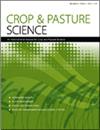开花期施氮通过促进韧皮部氨基酸的动员而增加大麦籽粒蛋白质
IF 1.9
4区 农林科学
Q2 AGRICULTURE, MULTIDISCIPLINARY
引用次数: 0
摘要
抽象的上下文。在麦芽行业,大麦谷物的蛋白质含量低是一个主要问题。克服这个问题的一个有效策略是在初始施肥的基础上,在花期前后在叶面施用氮肥。目标本研究旨在进一步了解在常规管理下生长的植物对花期叶面氮肥的代谢调节。方法。在三个商业试验点进行了花期叶面施氮两种不同速率的田间试验,试验采用了每个农民的惯常做法。关键的结果。籽粒蛋白质含量随叶片施肥而增加,但不影响叶片衰老和氮素再动员效率。大麦植株也表现出对花期施氮的快速同化,增加了籽粒灌浆期间叶片氮有机库和全球韧皮部氨基酸动员。这些结果可能与谷氨酰胺合成酶1和两种氨基酸转运蛋白(HvAAP6和HvAAP7)的基因表达增加有关。结论。施用的叶面氮素被迅速吸收并高效输出到籽粒,对营养器官的氮素贡献没有负面影响。此外,韧皮部氮的贡献对籽粒蛋白质含量有重要影响。的影响。花期叶面施肥是纠正籽粒蛋白质含量以满足小麦需求的有效策略,因为它不影响预同化氮的再动员,并且在本文探讨的不同养分有效性(氮充足、氮缺乏和硫缺乏)下都是有用的。本文章由计算机程序翻译,如有差异,请以英文原文为准。
Nitrogen application at anthesis increases barley grain protein by enhancing phloem amino acid mobilisation
ABSTRACT Context. In the malting industry, the low protein content of barley grains is a major issue. A useful strategy to overcome this problem is to complement the initial fertilisation with a foliar application of nitrogen (N) near anthesis. Aims. This study aimed to advance knowledge of the metabolic adjustments displayed by plants grown under common management practices in response to foliar N fertilisation at anthesis. Methods. Field experiments with two different rates of foliar N application near anthesis were performed at three commercial sites under the common practice of each farmer. Key results. Grain protein content increased upon foliar fertilisation in all sites without affecting leaf senescence or N remobilisation efficiency. Barley plants also showed a rapid assimilation of the N applied at anthesis, increasing the leaf N organic pools and the global phloem amino acid mobilisation during grain filling. These results could be attributed to the increase in the gene expression of glutamine synthetase 1 and two amino acid transporters (HvAAP6 and HvAAP7). Conclusions. Foliar N applied was rapidly assimilated and exported with high efficiency to the grain with no negative impact over the contribution of N from vegetative organs. Furthermore, phloem N contribution was shown to be of major importance for grain protein content. Implications. Foliar fertilisation near anthesis is an efficient strategy to correct grain protein content to meet maltsters’ requirements because it did not affect pre-assimilated N remobilisation, and was useful under the different nutrient availabilities explored here (N sufficiency, N deficiency and sulfur deficiency).
求助全文
通过发布文献求助,成功后即可免费获取论文全文。
去求助
来源期刊

Crop & Pasture Science
AGRICULTURE, MULTIDISCIPLINARY-
CiteScore
4.20
自引率
15.80%
发文量
111
审稿时长
3 months
期刊介绍:
Crop and Pasture Science (formerly known as Australian Journal of Agricultural Research) is an international journal publishing outcomes of strategic research in crop and pasture sciences and the sustainability of farming systems. The primary focus is broad-scale cereals, grain legumes, oilseeds and pastures. Articles are encouraged that advance understanding in plant-based agricultural systems through the use of well-defined and original aims designed to test a hypothesis, innovative and rigorous experimental design, and strong interpretation. The journal embraces experimental approaches from molecular level to whole systems, and the research must present novel findings and progress the science of agriculture.
Crop and Pasture Science is read by agricultural scientists and plant biologists, industry, administrators, policy-makers, and others with an interest in the challenges and opportunities facing world agricultural production.
Crop and Pasture Science is published with the endorsement of the Commonwealth Scientific and Industrial Research Organisation (CSIRO) and the Australian Academy of Science.
 求助内容:
求助内容: 应助结果提醒方式:
应助结果提醒方式:


